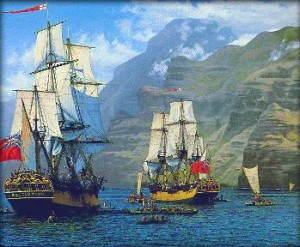Late 1700s Timber Resources Meet Needs of Growing Industries
With the opening of Hawai‘i to the outside world after the arrival of Captain James Cook in 1778, Hawaii’s timber resources supplied the needs, particularly for fuel wood, of the many trading and whaling vessels that plied the Pacific maritime routes in the late 1700s and the 1800s.
In addition, as many as six to seven hundred cords a year (1444 m3 – 1685 m3/282,000 fbm – 329000 fbm) of fuel wood were used at the mills of the growing sugar industry in Hawai‘i. This practice lasted approximately 50 years until the mid 1880s when the majority of plantations had converted to coal or new technologies that used residue from sugar cane–-called bagasse–for fuel.
Image–Captain Cook’s Moment of Discovery Kaua’i January 19, 1778. Courtesy, Artist, Raymond A. Massey, Ship Store Galleries, Kapaa, Kaua’i.

Forest Ecosystem Services
“Ecosystem Services are commonly defined as benefits people obtain from ecosystems. The Millennium Ecosystem Assessment – a four-year United Nations assessment of the condition and trends of the world’s ecosystems – categorizes ecosystem services as:
- Provisioning Services or the provision of food, fresh water, fuel, fiber, and other goods;
- Regulating Services such as climate, water, and disease regulation as well as pollination;
- Supporting Services such as soil formation and nutrient cycling; and
- Cultural Services such as educational, aesthetic, and cultural heritage values as well as recreation and tourism.”
This excerpt from the United States Department of Agriculture website explains the broad roles ecosystems play in our lives–Hawaii Forest Tracks takes it one step further by exploring the ecosystems of forests in Hawaii. Join us to discover the many layers of these contributions through historic information, news and feedback.

